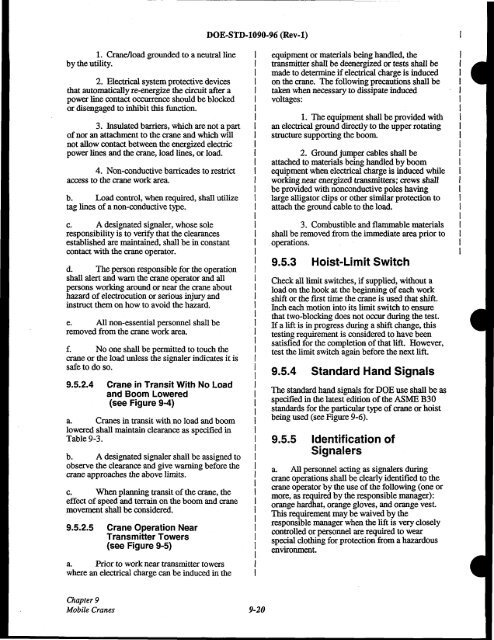DOE-STD-1090-96, DOE Standard Hoisting and Rigging Manual ...
DOE-STD-1090-96, DOE Standard Hoisting and Rigging Manual ...
DOE-STD-1090-96, DOE Standard Hoisting and Rigging Manual ...
You also want an ePaper? Increase the reach of your titles
YUMPU automatically turns print PDFs into web optimized ePapers that Google loves.
<strong>DOE</strong>-<strong>STD</strong>-I090-<strong>96</strong> (Rev-I)1. Cranel10ad grounded to a neutral lineby the utility.2. Electrical system protective devicesthat automatically re-energize the circuit after apower line contact occurrence should be blockedor disengaged to inhibit this function.3. Insulated barriers, which are not a partofnor an attachment to the crane <strong>and</strong> which willnot allow contact between the energized electricpower lines <strong>and</strong> the crane, load lines, or load.4. Non-conductive barricades to restrictaccess to the crane work area.b. Load control, when required, shall utilizetag lines of a non-conductive type.c. A designated signaler, whose soleresponsibility is to verify that the clearancesestablished are maintained, shall be in constantcontact with the crane operator.d. The person responsible for the operationshall alert <strong>and</strong> warn the crane operator <strong>and</strong> allpersons working around or near the crane abouthazard ofelectrocution or serious injury <strong>and</strong>instruct them on how to avoid the hazard.e. All non-essential personnel shall beremoved from the crane work area.f. No one shall be permitted to touch thecrane or the load unless the signaler indicates it issafe to do so.9.5.2.4 Crane in Transit With No Load<strong>and</strong> Boom Lowered(see Figure 9-4)a. Cranes in transit with no load <strong>and</strong> boomlowered shall maintain clearance as specified inTable 9-3.b. A designated signaler shall be assigned toobserve the clearance <strong>and</strong> give warning before thecrane approaches the above limits.c. When planning transit ofthe crane, theeffect of speed <strong>and</strong> terrain on the boom <strong>and</strong> cranemovement shall be considered.9.5.2.5 Crane Operation NearTransmitter Towers(see Figure 9-5)a. Prior to work near transmitter towerswhere an electrical charge can be induced in theequipment or materials being h<strong>and</strong>led, thetransmitter shall be deenergized or tests shall bemade to determine ifelectrical charge is inducedon the crane. The following precautions shall betaken when necessary to dissipate inducedvoltages:1. The equipment shall be provided withan electrical ground directly to the upper rotatingstructure supporting the boom.2. Ground jumper cables shall beattached to materials being h<strong>and</strong>led by boomequipment when electrical charge is induced whileworking near energized transmitters; crews shallbe provided with nonconductive poles havinglarge alligator clips or other similar protection toattach the ground cable to the load.3. Combustible <strong>and</strong> flammable materialsshall be removed from the immediate area prior to.operations.9.5.3Hoist-Limit SwitchCheck all limit switches, ifsupplied, without aload on the hook at the beginning ofeach workshift or the first time the crane is used that shift.Inch each motion into its limit switch to ensurethat two-blocking does not occur during the test.Ifa lift is in progress during a shift change, thistesting requirement is considered to have beensatisfied for the completion ofthat lift However,test the limit switch again before the next lift.9.5.4 <strong>St<strong>and</strong>ard</strong> H<strong>and</strong> SignalsThe st<strong>and</strong>ard h<strong>and</strong> signals for <strong>DOE</strong> use shall be asspecified in the latest edition ofthe ASME B30st<strong>and</strong>ards for the particular type ofcrane or hoistbeing used (see Figure 9-6).9.5.5 Identification ofSignalersa. All personnel acting as signalers duringcrane operations shall be clearly identified to thecrane operator by the use ofthe following (one ormore, as required by the responsible manager):orange hardhat, orange gloves, <strong>and</strong> orange vest.This requirement may be waived by theresponsible manager when the lift is very closelycontrolled orpersonnel are required to wearspecial clothing for protection from a hazardousenvironment.Chapter 9Mobile Cranes 9-20
















